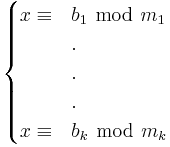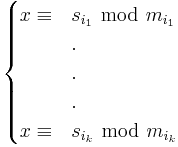Secret sharing using the Chinese remainder theorem
Secret sharing consists of recovering a secret S from a set of shares, each containing partial information about the secret. The Chinese remainder theorem (CRT) states that for a given system of simultaneous congruence equations, the solution is unique in some  , with
, with  under some appropriate conditions on the congruences. Secret sharing can thus use the CRT to produce the shares presented in the congruence equations and the secret could be recovered by solving the system of congruences to get the unique solution, which will be the secret to recover.
under some appropriate conditions on the congruences. Secret sharing can thus use the CRT to produce the shares presented in the congruence equations and the secret could be recovered by solving the system of congruences to get the unique solution, which will be the secret to recover.
Contents |
Secret sharing schemes: several types
There are several types of secret sharing schemes. The most basic types are the so-called threshold schemes, where only the cardinality of the set of shares matters. In other words, given a secret S, and n shares, any set of t shares is a set with the smallest cardinality from which the secret can be recovered, in the sense that any set of t-1 shares is not enough to give S. This is known as a threshold access structure. We call such schemes (t,n) threshold secret sharing schemes, or t-out-of-n scheme.
Threshold secret sharing schemes differ from one another by the method of generating the shares, starting from a certain secret. The first ones are Shamir's threshold secret sharing scheme, which is based on polynomial interpolation in order to find S from a given set of shares, and George Blakley's geometric secret sharing scheme, which uses geometric methods to recover the secret S. Threshold secret sharing schemes based on the CRT are due to Mignotte and Asmuth-Bloom, they use special sequences of integers along with the CRT.
Chinese remainder theorem
Let  ,
,  , and
, and  . The system of equations
. The system of equations

has solutions in  if and only if
if and only if  for all
for all  , where
, where  denotes the greatest common divisor (GCD) of
denotes the greatest common divisor (GCD) of  and
and  . Furthermore, under these conditions, the system has a unique solution in
. Furthermore, under these conditions, the system has a unique solution in  where
where ![n = [m_1,...,m_k]](/2012-wikipedia_en_all_nopic_01_2012/I/34cffe1f4ac1dde71246f16cf37b18ee.png) , which denotes the least common multiple (LCM) of
, which denotes the least common multiple (LCM) of  .
.
Secret sharing using the CRT
Since the Chinese remainder theorem provides us with a method to uniquely determine a number S modulo k many relatively prime integers  , given that
, given that  , then, the idea is to construct a scheme that will determine the secret S given any k shares (in this case, the remainder of S modulo each of the numbers
, then, the idea is to construct a scheme that will determine the secret S given any k shares (in this case, the remainder of S modulo each of the numbers  ), but will not reveal the secret given less than k of such shares.
), but will not reveal the secret given less than k of such shares.
Ultimately, we choose n relatively prime integers  such that S is smaller than the product of any choice of k of these integers, but at the same time is greater than any choice of k-1 of them. Then the shares
such that S is smaller than the product of any choice of k of these integers, but at the same time is greater than any choice of k-1 of them. Then the shares  are defined by
are defined by  for
for  . In this manner, thanks to the CRT, we can uniquely determine S from any set of k or more shares, but not from less than k. This provides the so-called threshold access structure.
. In this manner, thanks to the CRT, we can uniquely determine S from any set of k or more shares, but not from less than k. This provides the so-called threshold access structure.
This condition on S can also be regarded as  . Since S is smaller than the smallest product of k of the integers, it will be smaller than the product of any k of them. Also, being greater than the product of the greatest k-1 integers, it will be greater than the product of any k-1 of them.
. Since S is smaller than the smallest product of k of the integers, it will be smaller than the product of any k of them. Also, being greater than the product of the greatest k-1 integers, it will be greater than the product of any k-1 of them.
There are two Secret Sharing Schemes that utilize essentially this idea, Mignotte's and Asmuth-Bloom's Schemes, which are explained below.
Mignotte's threshold secret sharing scheme
As said before, Mignotte's threshold secret sharing scheme uses, along with the CRT, special sequences of integers called the (k,n)-Mignotte sequences which consist of n integers, pairwise coprime, such that the product of the smallest k of them is greater than the product of the k-1 biggest ones. This condition is crucial because the scheme is built on choosing the secret as an integer between the two products, and this condition ensures that at least k shares are needed to fully recover the secret, no matter how they are chosen.
Formally, let  be an integer, and k be an integer such that
be an integer, and k be an integer such that  . A (k,n)-Mignotte sequence is a strictly increasing sequence of positive integers
. A (k,n)-Mignotte sequence is a strictly increasing sequence of positive integers  , with
, with  for all
for all  , such that
, such that  . We call this range the authorized range. Now, the scheme works as follows: We build a (k,n)-threshold secret sharing scheme. We choose the secret S as a random integer in the authorized range. We compute, for every
. We call this range the authorized range. Now, the scheme works as follows: We build a (k,n)-threshold secret sharing scheme. We choose the secret S as a random integer in the authorized range. We compute, for every  , the reduction modulo
, the reduction modulo  of S that we call
of S that we call  , these are the shares. Now, for any k different shares
, these are the shares. Now, for any k different shares  , we consider the system of congruences:
, we consider the system of congruences: 
By the Chinese remainder theorem, since  are pairwise coprime, the system has a unique solution modulo
are pairwise coprime, the system has a unique solution modulo  . By the construction of our shares, this solution is nothing but the secret S to recover.
. By the construction of our shares, this solution is nothing but the secret S to recover.
Asmuth-Bloom's threshold secret sharing scheme
This scheme also uses special sequences of integers. Let  be an integer, and k be an integer such that
be an integer, and k be an integer such that  . We consider a sequence of pairwise coprime positive integers
. We consider a sequence of pairwise coprime positive integers  such that
such that  . For this given sequence, we choose the secret S as a random integer in the set
. For this given sequence, we choose the secret S as a random integer in the set  .
.
We then pick a random integer  such that
such that  . We compute the reduction modulo
. We compute the reduction modulo  of
of  , for all
, for all  , these are the shares
, these are the shares  . Now, for any k different shares
. Now, for any k different shares  , we consider the system of congruences:
, we consider the system of congruences:

By the Chinese remainder theorem, since  are pairwise coprime, the system has a unique solution
are pairwise coprime, the system has a unique solution  modulo
modulo  . By the construction of our shares, the secret S is the reduction modulo
. By the construction of our shares, the secret S is the reduction modulo  of
of 
It is important to notice that the Mignotte and Asmuth-Bloom (k,n)-threshold secret-sharing schemes are not perfect schemes, in the sense that a set of less than k shares contains some information about the secret. Nevertheless, by a suitable choice of the sequences and the parameters ( in the Asmuth-Bloom case), one can get a reasonable security factor. This is why the Asmuth-Bloom scheme is more secure, for it involves more random parameters.
in the Asmuth-Bloom case), one can get a reasonable security factor. This is why the Asmuth-Bloom scheme is more secure, for it involves more random parameters.
Example
The following is an example on the Asmuth-Bloom's Scheme. For practical purposes we choose small values for all parameters. We choose k=3 and n=4. Our pairwise coprime integers being  3,
3,  11,
11,  13,
13,  17 and
17 and  19. They satisfy the Asmuth-Bloom required sequence because
19. They satisfy the Asmuth-Bloom required sequence because  .
.
Say our secret S is 2. Pick  , satisfying the required condition for the Asmuth-Bloom scheme. Then
, satisfying the required condition for the Asmuth-Bloom scheme. Then  and we compute the shares for each of the integers 11, 13, 17 and 19. They are respectively 1, 12, 2 and 3. We consider one possible set of 3 shares: among the 4 possible sets of 3 shares we take the set {1,12,2} and show that it recovers the secret S=2. Consider the following system of congruences:
and we compute the shares for each of the integers 11, 13, 17 and 19. They are respectively 1, 12, 2 and 3. We consider one possible set of 3 shares: among the 4 possible sets of 3 shares we take the set {1,12,2} and show that it recovers the secret S=2. Consider the following system of congruences:

To solve the system, let  . From a constructive algorithm for solving such a system, we know that a solution to the system is
. From a constructive algorithm for solving such a system, we know that a solution to the system is  , where each
, where each  is found as follows:
is found as follows:
By Bézout's identity, since  , there exist positive integers
, there exist positive integers  and
and  , that can be found using the Extended Euclidean algorithm, such that
, that can be found using the Extended Euclidean algorithm, such that  . Set
. Set  .
.
From the identities  , we get that
, we get that  , and the unique solution modulo
, and the unique solution modulo  is 155. Finally,
is 155. Finally,  .
.
See also
References
- Oded Goldreich, Dana Ron and Madhu Sudan, Chinese Remaindering with Errors, IEEE Transactions on Information Theory, Vol. 46, No. 4, July 2000, pages 1330-1338.
- C.A. Asmuth and J. Bloom. A modular approach to key safeguarding. IEEE Transactions on Information Theory, IT-29(2):208-210, 1983.
- Sorin Iftene. General Secret Sharing Based on the Chinese Remainder Theorem with Applications in E-Voting. Electronic Notes in Theoretical Computer Science (ENTCS). Volume 186 , (July 2007). Pages 67–84. Year of Publication: 2007. ISSN:1571-0661.
- Thomas H. Cormen, Charles E. Leiserson, Ronald L. Rivest, and Clifford Stein. Introduction to Algorithms, Second Edition. MIT Press and McGraw-Hill, 2001. ISBN 0-262-03293-7. Section 31.5: The Chinese remainder theorem, pages 873-876.
- Ronald Cramer. Basic Secret Sharing (Lectures 1-2), Class Notes. October 2008, version 1.1.